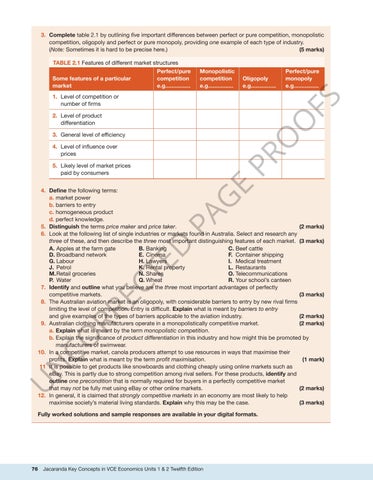“c02DecisionMakingInMarkets_PrintPDF” — 2022/5/25 — 13:13 — page 76 — #10
3. Complete table 2.1 by outlining five important differences between perfect or pure competition, monopolistic competition, oligopoly and perfect or pure monopoly, providing one example of each type of industry. (Note: Sometimes it is hard to be precise here.) (5 marks) TABLE 2.1 Features of different market structures Perfect/pure competition e.g................
Some features of a particular market
Monopolistic competition e.g................
Oligopoly e.g................
FS
1. Level of competition or number of firms
Perfect/pure monopoly e.g................
O
2. Level of product differentiation
O
3. General level of efficiency
PR
4. Level of influence over prices
E
5. Likely level of market prices paid by consumers
U
N
CO RR EC
TE
D
PA
G
4. Define the following terms: a. market power b. barriers to entry c. homogeneous product d. perfect knowledge. 5. Distinguish the terms price maker and price taker. (2 marks) 6. Look at the following list of single industries or markets found in Australia. Select and research any three of these, and then describe the three most important distinguishing features of each market. (3 marks) A. Apples at the farm gate B. Banking C. Beef cattle D. Broadband network E. Cinema F. Container shipping G. Labour H. Lawyers I. Medical treatment J. Petrol K. Rental property L. Restaurants M. Retail groceries N. Shares O. Telecommunications P. Water Q. Wheat R. Your school’s canteen 7. Identify and outline what you believe are the three most important advantages of perfectly competitive markets. (3 marks) 8. The Australian aviation market is an oligopoly, with considerable barriers to entry by new rival firms limiting the level of competition. Entry is difficult. Explain what is meant by barriers to entry and give examples of the types of barriers applicable to the aviation industry. (2 marks) 9. Australian clothing manufacturers operate in a monopolistically competitive market. (2 marks) a. Explain what is meant by the term monopolistic competition. b. Explain the significance of product differentiation in this industry and how might this be promoted by manufacturers of swimwear. 10. In a competitive market, canola producers attempt to use resources in ways that maximise their profits. Explain what is meant by the term profit maximisation. (1 mark) 11 It is possible to get products like snowboards and clothing cheaply using online markets such as eBay. This is partly due to strong competition among rival sellers. For these products, identify and outline one precondition that is normally required for buyers in a perfectly competitive market that may not be fully met using eBay or other online markets. (2 marks) 12. In general, it is claimed that strongly competitive markets in an economy are most likely to help maximise society’s material living standards. Explain why this may be the case. (3 marks) Fully worked solutions and sample responses are available in your digital formats.
76
Jacaranda Key Concepts in VCE Economics Units 1 & 2 Twelfth Edition





















































